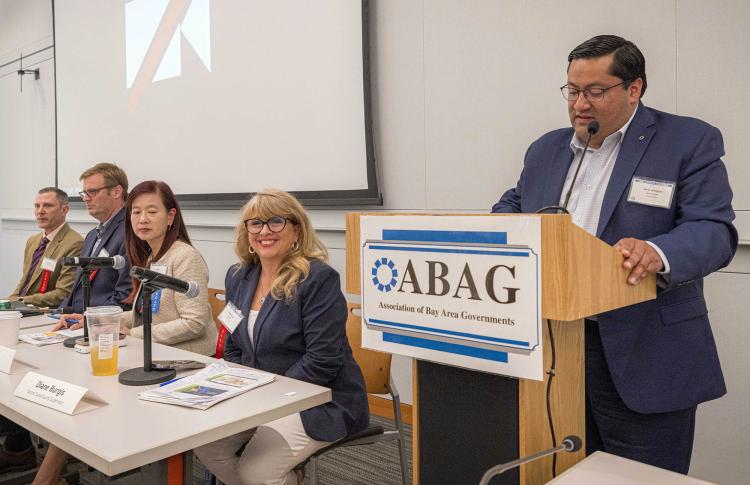
The year 2023 saw the Association of Bay Area Governments and its related agencies work in the challenging realms of housing, the environment and energy conservation with the goal of making the region more affordable, sustainable and healthy. Among ABAG’s achievements over the past year:
General Assembly Returns In-Person; Celebrates 60 Years(link is external)
June marked the first in-person General Assembly meeting since 2019 (view photos of the event(link is external)). A quorum of representatives from the Bay Area’s nine counties and 101 member cities convened to pass the 2023-2024 budget. Delegates attending exceeded quorum with 68 city and town representatives and six county representatives. The business meeting was followed by a two-part conference: Prosperity and the Power of Place in the Bay Area.
ABAG-MTC and partners Community Planning Collaborative received the 2023 Planning Agency Award of Excellence from the American Planning Association (APA) California Chapter for the Regional Housing Technical Assistance (RHTA) Program. This award brings state-level recognition to the 3-year-old program. The award was presented on Sept. 18 at the APA California 2023 Conference in Fresno. In presenting the award, APA CA President Andrea Ouse highlighted the program’s innovative approach in addressing critical regional needs, its high-quality outreach, engagement and collaboration, and its direct implementation efforts.
Workshops Address Questions About Possible Housing Bond Measure(link is external)
More than 550 people attended two summer public workshops hosted by the Bay Area Housing Finance Authority(link is external) (BAHFA) to provide information on strategies to work toward meeting the Bay Area’s housing needs. Central to BAHFA’s work is new funding for the production and preservation of affordable housing. Among the options is a bond measure that would be placed on the 2024 ballot in all nine Bay Area counties. BAHFA, a first-of-its-kind regional authority created to address the Bay Area’s chronic housing challenges, held the workshops as part of its public information effort around the potential bond, which could bring $10 billion to $20 billion to the nine-county Bay Area.
Plan Bay Area 2050+ Summer Engagement(link is external)
Nearly 3,000 Bay Area residents participated in summer 2023’s first round of engagement for Plan Bay Area 2050+, a limited and focused update to Plan Bay Area 2050,(link is external) the long-range plan for transportation, housing, the economy and the environment that was adopted by ABAG and the Metropolitan Transportation Commission (MTC) in late 2021. The public’s input will help staff refine Plan Bay Area 2050’s current plan strategies to reflect residents’ new realities as the Bay Area emerges from the COVID-19 pandemic, as well as their concerns for the future as it relates to the four plan elements of housing, the economy, transportation and the environment.
BayREN Celebrates 10 Years(link is external)
Led by the Association of Bay Area Governments, BayREN (Bay Area Regional Energy Network) is a regional collaboration of the Bay Area's nine counties and in 2023 celebrated its 10th anniversary(link is external) as it supports a greener Bay Area while tackling local issues such as housing, affordability, and resilience. BayREN(link is external) is able to address these issues through tailored approaches to program development, communication, and outreach, all stemming from local governments that are most familiar with their unique challenges. BayREN has helped mitigate 156 tons of carbon, upgraded 60,695 housing units and provided $55.4 million in incentives to make help make the region more environmentally friendly.
A first-of-its-kind horizontal levee project providing a host of ecological benefits(link is external) — led by the San Francisco Estuary Partnership and the city of Palo Alto — has received $2.1 million from the U.S. Environmental Protection Agency for construction in Fall 2024. Horizontal levees utilize a gently vegetated slope to provide multiple benefits including wave mitigation, enhancement of transitional habitat between tidal wetlands and terrestrial uplands, and filtering treated wastewater.
Bay Trail Equity Strategy Released(link is external)
The San Francisco Bay Trail, a joint project of ABAG and the Metropolitan Transportation Commission (MTC), is a series of connected walking and cycling paths that ring the San Francisco and San Pablo bays. The Bay Trail Equity Strategy is a multi-year plan to look at how to develop a Bay Trail that is accessible and welcoming to all people in the Bay Area. The first deliverable, the Bay Trail Equity Strategy Phase I History and Existing Conditions Study(link is external), is intended to help Bay Trail decision-makers understand and address historic and present-day inequities.
Flood, Fire, Heat, Drought: BARC Report Charts Course for Coordinated Adaptation(link is external)
A new report(link is external) issued by the Bay Area Regional Collaborative (link is external)(BARC) in October documented how the overall climate adaptation system in the Bay Area functions and identifies next steps in exploring responses to address sea level rise, inland flooding, water quality, drought, extreme heat, wildfire and air quality. The report lays the foundation for creating a more robust and coordinated system for adapting to and adequately preparing for changing climate conditions throughout the Bay Area. This is a complex challenge requiring cities, counties and regional agencies to coordinate a collective response to a wide array of hazards.
Video Highlights San Francisco Bay Restoration Authority(link is external)
The San Francisco Bay Restoration Authority is responsible for allocating funds raised by voter-approved Measure AA, the 2016 San Francisco Bay Clean Water, Pollution Prevention and Habitat Restoration Measure. Each year, the Authority has about $25 million in grant funding available for projects that protect and restore San Francisco Bay by: reducing trash, pollution and harmful toxins; improving water quality; restoring habitat for fish, birds, and wildlife; protecting communities from floods; and increasing shoreline public access and recreational areas. The Restoration Authority is staffed by the State Coastal Conservancy(link is external) and the Association of Bay Area Governments(link is external), including the San Francisco Estuary Partnership(link is external), under a Joint Powers Agreement.

